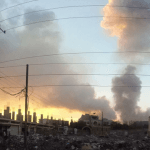Although this was presented to the West Coast Socialist Scholars Conference in April 1993, it has never been published. We do so now because the issues raised here still speak to problems faced by serious Marxists in Iran and beyond – Editors
 The period leading to the Iranian Revolution of 1979 was in general marked along the same lines as the international Marxist movement, i.e., the same concepts and thinking. This division embodied itself essentially along the lines or patterns of pro-Soviet, guerilla warfare, Maoism, and Trotskyism. During this era the Iranian Left was experiencing serious practical and ideological problems, both inside and outside the country. The internal problems generally embodied themselves around the question of tactics, survival, or organization in underground conditions, and at the same time contacts with the masses, with respect to the development of new forces of revolution, and the debates around various conceptions of the nature of revolution. The external movement debates revolved around the structure of socialism, debates revolving around Chinese or Russian or Albanian attempts. At the same time, the Iranian bourgeois opposition could not gain any mass appeal in responding to the radical demands of the masses. The Islamic movement that had arisen in Iran, and had various tendencies, shifted towards the leadership of Khomeini due to his uncompromising stand against the Shah.
The period leading to the Iranian Revolution of 1979 was in general marked along the same lines as the international Marxist movement, i.e., the same concepts and thinking. This division embodied itself essentially along the lines or patterns of pro-Soviet, guerilla warfare, Maoism, and Trotskyism. During this era the Iranian Left was experiencing serious practical and ideological problems, both inside and outside the country. The internal problems generally embodied themselves around the question of tactics, survival, or organization in underground conditions, and at the same time contacts with the masses, with respect to the development of new forces of revolution, and the debates around various conceptions of the nature of revolution. The external movement debates revolved around the structure of socialism, debates revolving around Chinese or Russian or Albanian attempts. At the same time, the Iranian bourgeois opposition could not gain any mass appeal in responding to the radical demands of the masses. The Islamic movement that had arisen in Iran, and had various tendencies, shifted towards the leadership of Khomeini due to his uncompromising stand against the Shah.
The important factor for us here is the attitude of the Left towards Khomeini’s fundamentalism. The manner in which the Iranian Left conceptualized and analyzed the Islamic movement was based on a seriously flawed understanding of Marxism. I would like to show how a superficial understanding of Marxism led to a deep ideological crisis in the Left, theoretically and organizationally. This allowed the counter-revolution to arise from within the revolution itself.
I would like to show here that the political-ideological-organizational crisis had a common nature and that was the philosophical and methodological understanding that predominated all in the movement. Specifically, I am referring to the vulgar understanding of dialectical materialism, with respect to the relationship of ideal to material conditions, and superstructure to mode of production. Traditionally the Left tied the economy (objective situation) to political superstructure in a deterministic way. Out of this notion two major approaches to Khomeini’s Islamic movement arose.
The first attitude held that since Iran has a capitalist mode of production that is contradictory to the fundamentalist nature of Khomeini’s movement, an alliance could be made with Khomeini in order to remove the Shah’s regime. Thus, even after the overthrow of the Shah, it continued with this policy by aligning with Khomeini against the Liberals, which it considered as the main threat to its gaining power. From this standpoint Khomeini’s hold on power would be unstable and temporary, or in a historical sense a vanishing moment.[1] Therefore, given that deterministic linking, the pre-capitalist nature of pro-Islamic forces would be incompatible with the essentially capitalist mode of production of Iran. The conclusion of this period would be power in the hands of Leftist forces with a little help from the friendly neighbor in the north.[2]
That leads us to the other version of a deterministic understanding of this relationship. This version was generally more radical and generally held by forces sympathetic to Maoism’s rejection of Russian social imperialism. They also believed that Iran was a capitalist society, and based on that, held that Khomeini’s forces which had taken over the bourgeois state automatically become bourgeois, a faction of the world bourgeois.
Therefore, you can see how wrong these forces were in their politics, tactics and strategy.
If you consider the pro-Islamic fundamentalist anti-imperialism from a reactionary pre-capitalist standpoint (which was a historical element of the Asiatic mode of production), the lack of understanding of the dialectical relationship of appearance to essence, for example in respect to human liberation and freedom which should have been the ultimate goal of the revolutionary movement was set aside for the mere appearance of anti-imperialist action on the part of the pro-Islamic movement.
There were other aspects of the pro-Islamic movement that made it appear as a populist movement, such as its identification with the oppressed masses and its humble posture.
Thus, instead of freedom as goal as essence they are swayed by semblance in the opposition to imperialism, as if it automatically meant that they were populist.
Crisis in the Iranian Left and its cause
With the outbreak of the Iraq-Iran war in the fall of 1980, the crisis within the Left heightened. Despite the various forms the crisis took, there was a common factor. A major crisis was that the established Left’s concepts of Marxism and of revolution were put into question, and they were found insufficient.
At the time I was a member of a tendency called Razme Kargar. As opposed to many other tendencies, which were looking for a formal change of platform and organization, we felt that the crisis is not only national and is not accidental, but is global and historical and has its own laws of development. The solution to this crisis, in the final analysis can be explained by the methodological and philosophical misunderstanding of Marxism and Leninism. This established our starting point, that without a methodological transformation it is not possible to achieve an ideological transformation. Searching for dialectics became our starting point for recreating the Marxism of Marx for our age.
A general study of the available philosophical works of Marx, Engels and Lenin such as Anti-Dühring, Ludwig Feuerbach, or Materialism and Empirio-Criticism, was not sufficient to answer our questions regarding the need for new revolutionary theory for our historical era, to unite Marx’s universal idea and the freedom movements of the present era. This search for new ideas was not an easy task when you consider that during this period people were being arrested tortured for having a leftist pamphlet. Our continuous search led us to two important points which were new to us: (1) the Philosophical Notebooks of Lenin, written in 1914-16; (2) Marx’s concept of Alienated Labor and his writings on method in the Grundrisse. Both of these made us aware of the relation of Marxism to Hegelian Dialectics.
This new understanding of dialectics opened new doors to us, theoretically and organizationally. Without having a deep knowledge of Marx’s Humanism and his Critique of the Hegelian Dialectic in the 1844 Manuscripts, we saw organization as the place to practice new human relations, which was contradictory with our past vanguardist backgrounds, and at the same time this had to be worked out concretely for our conditions of struggle under the totalitarian dictatorship of Khomeini. Theoretically, our critique of Mao and Stalin was raised to a new methodological and philosophical level. We no longer considered either Russia or China as socialist societies, but rather as state-capitalist. This raised many questions about the nature of socialism and its relation to our current struggle for freedom and the type of organization needed to achieve that.
From the vantage point of today, I can see that following Lenin’s Philosophical Notebooks, which looks at Hegel materialistically, was not sufficient to grasp the totality of Marx’s Marxism and it was insufficient in answering the many questions that had arisen for us at this stage. For that we needed a philosophy of liberation that would address all these questions concretely: What is the vision of the new society, how does it relate to the concept of organization, what is the relationship of philosophy and organization, what are the responsibilities of the revolutionary intellectual in relation to idea of freedom and the self-development of the mass movement, and finding and working out the original principles that a continuity with Marx and this totality can achieve?
At the time we were unable to see Lenin’s philosophical ambivalence and could not work out these questions. Because we couldn’t clarify the relationship of philosophy and organization, the organization was no longer viable in addressing the questions that confronted the movement.
It is only in recent years that I have come to know the works of Raya Dunayevskaya, who has developed comprehensively the questions we were in search for an answer to.
The Iranian Revolution was a major social upheaval. In terms of mass participation it involved almost the entire population of tens of millions in direct action. Out of it arose many new struggles and new dimensions. Women, youth, minorities, and peasants all participated. The sense of empowerment was awesome. It is that experience that also reveals major contradictions in the thinking of the Left that cannot be ignored.
[1] Even the Left was naively drawing an historical parallel with the short-lived Kerensky government in Russia after April 1917.
[2] This notion was held by pro-Soviet Fedayii guerrillas.







0 Comments